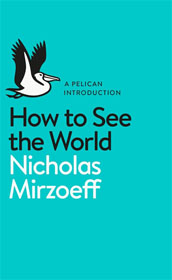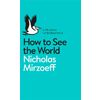This article is more than 1 year old
I Saw a Man, Once Upon a Time in Russia and How to See the World
Potent plots, oligarchs and overlords and much, much more
How to See the World
"This book is designed to help you see the much-changed and changing world. It is a guide to the visual culture we live in."
So claims Nicholas Mirzoeff in the introduction to How To See The World. The first chapter is the same as the book's title and features the famous ‘Blue Marble’ photograph of Earth taken from an Apollo spacecraft, the first time the author claims that humanity could see itself as a whole.
Mirzoeff introduces us to the concept of the future via The Sex Pistols, who claimed that there wasn't one, and William Gibson, the purveyor of cyberspace and sees our modern cities as: "Spaces of erasure, ghosts and fakes".
We move on to how we see ourselves and soon encounter the ubiquitous selfie: "A fusion of the self image, the self portrait of the artist as a hero and the machine image of modern art that works as a digital performance".
We are given a short lesson in the history of portraiture before there are a few less enlightened views about the selfie — the man from Esquire says that they are: "The masturbation of the self image". While according to Roy Peter Clark of CNN they should be: "Selfish, self absorbed and narcissistic, the centre of our own universe".

The same could be said for this book, as there is no chapter entitled "How we see each other", in fact according to Mirzoeff, we don't seem to see much at all without an intervening media. This book has many of the shortcomings of Philip Ball's Invisible which I reviewed last summer, in that the author has chosen a massive subject which is nigh-on impossible to cover completely and satisfy all.
That said, this book has more interesting sources and a breezier style. It is also very media and sociologically based, and there's a dash of science, but not much...
We are reminded that it is the brain that sees, not the eye. Then there is a rather random diversion of a chapter about military surveillance with walk-ons from Napoleon and Clausewitz before we are catapulted through the age of aerial photography and onwards to the day of the drones.
Sexuality and gender also make a guest appearance, and there are plenty of nuggets of info. I am reminded that obscene means "off stage". There are literary references too numerous to mention from Charles Baudelaire flaneuring around nineteenth century Paris to China Mieville, unseeing The City and the City before we are brought down to earth in the less fictitious cities where The Arab Spring and Occupy took place.
The slogan: "They do not represent us" is bandied around by the author. Yet it begs the question: How do we represent ourselves? Which is a question not completely answered by this flawed, messy, yet interesting book.
The author finishes with a rousing call to arms: "Once we have learned how to see the world, we have only taken one of the required steps. The point is to change it".
This book is likely to appeal to students and media practitioners, it covers similar ground to the French philosophers of the 1970s such as Roland Barthes who are mostly conspicuous by their absence. As an introduction to modern media theories, it is passable, though the title probably promises too much and overall it is likely to disappoint more discerning readers. ®
 Author Nicholas Mirzoeff
Author Nicholas Mirzoeff
Title How To See The World
Publisher Pelican
Price £8.99 (Paperback), £6.49 (eBook)
More info Publication web site
